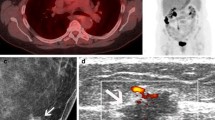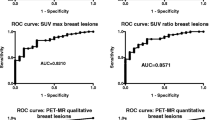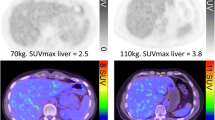Abstract
Purpose
The aim of this study was to evaluate the frequency and clinical significance of unexpected focal 18F-fluorodeoxyglucose (FDG) uptake localized by PET/CT within the breast.
Methods
The files of 4,038 consecutive female cancer patients referred for FDG PET/CT over a period of 74 months were retrospectively reviewed. Patients with breast cancer were excluded from the study. The incidence of focal sites of increased FDG uptake localized by PET/CT to the breast was determined. The intensity of uptake was measured using the lean body mass maximum standard uptake value (LBM SUVmax), and the presence and patterns of morphologic changes on CT were assessed. The etiology and clinical significance of findings were confirmed histologically or with imaging and clinical follow-up.
Results
Unexpected FDG foci in the breast were identified in 33 of 4,038 patients (0.82%). Follow-up data were available for 30 patients. Malignancy was diagnosed in 17 patients (histology 12, clinical 5) and excluded in 13 patients (histology 9, clinical 4). There was a borderline statistically significant difference in FDG uptake (LBM SUVmax) between malignant (3.13 ± 2.25) and benign (1.85 ± 1.18) lesions (p = 0.05). Focal lesions were seen on CT in 23 patients (malignant 11, benign 12), and CT was negative in 7 patients (malignant 6, benign 1).
Conclusion
Although rare, incidental focal abnormal FDG uptake in the breast may represent malignant lesions in up to 57% of patients. Breast incidentalomas on PET/CT warrant further assessment including tissue sampling to define the etiology of these unexpected FDG-avid foci.

Similar content being viewed by others
References
Bar-Shalom R, Valdivia AY, Blaufox MD. PET imaging in oncology. Semin Nucl Med 2000;30:150–85. doi:10.1053/snuc.2000.7439.
Kostakoglu L, Agress H Jr, Goldsmith SJ. Clinical role of FDG-PET in evaluation of cancer patients. Radiographics 2003;23:315–40. doi:10.1148/rg.232025705.
Bohuslavizki KH, Klutmann S, Kröger S, Sonnemann U, Buchert R, Werner JA, et al. FDG PET detection of unknown primary tumors. J Nucl Med 2000;41:816–22.
Bar-Shalom R, Yefremov N, Guralnik L, Gaitini D, Frenkel A, Kuten A, et al. Clinical performance of PET/CT in evaluation of cancer: additional value for diagnostic imaging and patient management. J Nucl Med 2003;44:1200–9.
Cook G, Fogelman I, Maisey MN. Normal physiological and benign pathological variants of 18-fluoro-2-deoxyglucose positron-emission tomography scanning: potential for error in interpretation. Semin Nucl Med 1996;26:308–14. doi:10.1016/S0001-2998(96)80006-7.
Bakheet SM, Powe J. Benign causes of 18-FDG uptake on whole body imaging. Semin Nucl Med 1998;28:352–8. doi:10.1016/S0001-2998(98)80038-X.
Kostakoglu L, Hardoff R, Mirtcheva R, Goldsmith SJ. PET-CT fusion imaging in differentiating physiologic from pathologic FDG uptake. Radiographics 2004;24:1411–31. doi:10.1148/rg.245035725.
Agress H, Cooper BZ. Detection of clinically unexpected malignant and premalignant tumors with whole-body FDG PET: histopathologic comparison. Radiology 2004;230:417–22. doi:10.1148/radiol.2302021685.
Ishimori T, Patel PV, Wahl RL. Detection of unexpected additional primary malignancies with PET/CT. J Nucl Med 2005;46:752–7.
Shreve PD, Anzai Y, Wahi RL. Pitfalls in oncologic diagnosis with FDG PET imaging: physiologic and benign variants. Radiographics 1999;19:61–77.
Israel O, Yefremov N, Bar-Shalom R, Kagana O, Frenkel A, Keidar Z, et al. PET/CT detection of unexpected gastrointestinal foci of 18F-FDG uptake: incidence, localization patterns, and clinical significance. J Nucl Med 2005;46:758–62.
Kluetz PG, Meltzer CC, Villemagne VL, Kinahan PE, Chander S, Martinelli MA, et al. Combined PET/CT imaging in oncology: impact on patient management. Clin Positron Imaging 2000;3:223–30. doi:10.1016/S1095-0397(01)00055-3.
Yasuda S, Ide M. PET and cancer screening. Ann Nucl Med 2005;19:167–77. doi:10.1007/BF02984601.
Israel O, Mor M, Guralnik L, Hermoni N, Gaitini D, Bar-Shalom R, et al. Is 18F-FDG PET/CT useful for imaging and management of patients with suspected occult recurrence of cancer? J Nucl Med 2004;45:2045–51.
American College of Radiology. Breast imaging reporting and data system (BI-RADS). 4th ed. Reston: American College of Radiology; 2003.
Inoue M, Sano T, Watai R, Ashikaga R, Ueda K, Watatani M, et al. Dynamic multidetector CT of breast tumors: diagnostic features and comparison with conventional techniques. AJR Am J Roentgenol 2003;181:679–86.
Kim TY, Kim WB, Ryu JS, Gong G, Hong SJ, Shong YK. 18F-fluorodeoxyglucose uptake in thyroid from positron emission tomogram (PET) for evaluation in cancer patients: high prevalence of malignancy in thyroid PET incidentaloma. Laryngoscope 2005;115:1074–8. doi:10.1097/01.MLG.0000163098.01398.79.
Tatlidil R, Jadvar H, Bading JR, Conti PS. Incidental colonic fluorodeoxyglucose uptake: correlation with colonoscopic and histopathologic findings. Radiology 2002;224:783–7. doi:10.1148/radiol.2243011214.
Dockery KF, Puri S, Qazi R, Davis D. FDG-PET on the trail of an unsuspected primary malignancy in the breast. Clin Nucl Med 2008;33:175–80. doi:10.1097/RLU.0b013e318162ddee.
Korn RL, Yost AM, May CC, Kovalsky ER, Orth KM, Layton TA, et al. Unexpected focal hypermetabolic activity in the breast: significance in patients undergoing 18F-FDG PET/CT. AJR Am J Roentgenol 2006;187:81–5. doi:10.2214/AJR.05.0548.
Rosen E, Turkington T, Soo M, Baker JA, Coleman RE. Detection of primary breast carcinoma with a dedicated, large-field-of-view FDG PET mammography device: initial experience. Radiology 2005;234:527–34. doi:10.1148/radiol.2342040654.
Levine EA, Freimanis RI, Perrier ND, Morton K, Lesko NM, Bergman S, et al. Positron emission mammography: initial clinical results. Ann Surg Oncol 2003;10:86–91. doi:10.1245/ASO.2003.03.047.
Scheidhauer K, Walter C, Seemann MD. FDG PET and other imaging modalities in the primary diagnosis of suspicious breast lesions. Eur J Nucl Med Mol Imaging 2004;31(Suppl 1):S70–9. doi:10.1007/s00259-004-1528-7.
Zangheri B, Messa C, Picchio M, Gianolli L, Landoni C, Fazio F. PET/CT and breast cancer. Eur J Nucl Med Mol Imaging 2004;31(1):S135–42. doi:10.1007/s00259-004-1536-7.
Author information
Authors and Affiliations
Corresponding author
Rights and permissions
About this article
Cite this article
Litmanovich, D., Gourevich, K., Israel, O. et al. Unexpected foci of 18F-FDG uptake in the breast detected by PET/CT: incidence and clinical significance. Eur J Nucl Med Mol Imaging 36, 1558–1564 (2009). https://doi.org/10.1007/s00259-009-1147-4
Received:
Accepted:
Published:
Issue Date:
DOI: https://doi.org/10.1007/s00259-009-1147-4




